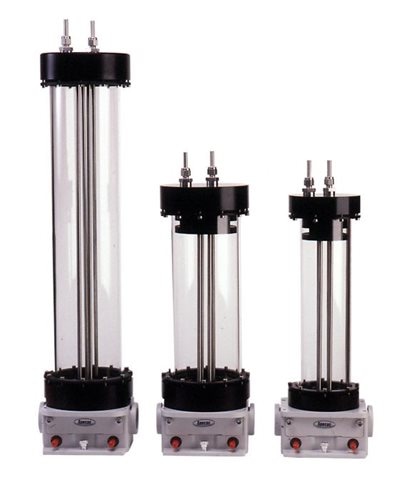The standard long pathlength gas cell range available from Specac is now the latest Atmos™ series of metal-bodied fixed-pathlength gas cells.
These cells have been improved using new optical modeling tools to provide the highest signal-to-noise.
| Model |
A2.5 |
A5 |
A10 |
A20 |
| Pathlength (m) |
2.5 |
5.0 |
10 |
20 |
| Base pathlength (mm) |
104 |
139 |
250 |
455 |
| Number of passes |
24 |
36 |
40 |
44 |
| Volume (L) |
0.27 |
0.63 |
2.12 |
3.68 |
The Atmos™ series can be heated to 200 °C with the inclusion of a temperature controller and heating jacket.
Why Atmos™?
- Low cell volume to facilitate rapid gas exchange
- Improved optical path for unparalleled signal-to-noise
- Retrofittable heating jacket option for up to 200 °C
- Maximum cell pressure of 125 psi (8.6 bar)
- Includes inert stainless-steel mirror substrates and does not contain glues, thus preventing outgassing
- Ni-coated Al cell bodies enable better thermal transfer from heating jackets; the Atmos™ series also holds higher gas pressure when compared to glass
Flexible Specification Long-Pathlength Gas Cells—Cyclone™ and Tornado™
Cyclone™ and Tornado™ cells are available with metal or glass cell bodies and can be configured to a range of pathlengths.
| Model |
C2 |
C5 or
T5 |
C10 or
T10 |
C20 or
T20 |
| Pathlength settings (m) |
0.5—2.5
in 0.5 m steps |
1.0—8.0
in 1.0 m steps |
2.1—10.6
in 1.06 m steps |
2.0—20.0
in 2.0 m steps |
| Base pathlength (mm) |
125 |
250 |
264 |
500 |
| Number of passes |
4—20 |
4—32 |
8—40 |
4—40 |
| Volume (L) |
0.19 |
1.33 |
2.60 |
4.30 |
Cyclone™ Versus Tornado™
- Tornado™ cells are a stripped-back offering, delivered as standard without outlet or inlet tap valves; they cannot be heated.
- Cyclone™ cells can be delivered with a fitted heating jacket for analyses of heated gases of up to 200 °C (unavailable for model C20)
- A modifiable mirror carriage can be installed into the Cyclone™ cells to allow users to change the pathlength throughout the given range.
Which Pathlength to Choose?
Gas absorbance relies on the distance traveled by the IR light beam across the gas sample. The association between pathlength (L), concentration (C), and absorbance (A) is given by Beer’s Law, as shown below:
A = -log10 (I/I0) = a.C.L
The concentrations of gases in the atmosphere are generally expressed in C.L units of ppm⋅m—the number of molecules encountered by the infrared beam across a 1.0-m path.
A gas at 0.1 ppm atmospheric concentration will be able to absorb as much IR light over 100-m pathlength as would the same gas at 10 ppm over 1 m or at 1 ppm over 10 m.
Therefore, the cell’s pathlength should be selected to give absorbance values within the linear range of the spectrometer for a specified concentration. The table given below can be considered as a guide:
| Gas name |
formula |
v (cm-1) |
ppm.m |
absorbance |
| Carbon dioxide |
CO2 |
2360 |
100 |
0.40 |
| Carbon monoxide |
CO |
2170 |
100 |
0.04 |
| Methane |
CH4 |
3020 |
100 |
0.10 |
| C2 to C6 n-alkanes |
|
2960 |
100 |
0.10 |
| Nitrogen dioxide |
NO2 |
1630 |
100 |
0.15 |
| Nitric oxide |
NO |
1900 |
100 |
0.015 |
| Sulfur dioxide |
SO2 |
1370 |
100 |
0.09 |
| Hydrogen sulfide |
H2S |
1300 |
1000 |
0.002 |
| Ammonia |
NH3 |
960 |
100 |
0.12 |
| Hydrogen chloride |
HCl |
2940 |
100 |
0.04 |
| Water |
H2O |
1650 |
1000 |
0.20 |
| Vinyl chloride |
CH2CHCl |
950, 900 |
100 |
0.06 |
| Acetaldehyde |
CH3CHO |
2750 |
100 |
0.015 |
| Benzene |
C6H6 |
670 |
10 |
0.09 |
| Toluene |
C6H5CH3 |
730, 690 |
100 |
0.10 |
| Methanol |
CH3OH |
1040 |
100 |
0.10 |
| Ethanol |
CH3CH2OH |
1050 |
100 |
0.05 |
| Carbonyl sulfide |
COS |
2070 |
100 |
0.40 |
| Nitrous oxide |
N2O |
2235 |
100 |
0.15 |
| Sulfur hexafluoride |
SF6 |
950 |
10 |
0.40 |
Features
- Ambient temperature operation
- Vacuum to 15 p.s.i. operation
- Wide pathlength range (1–20 m)
- Anodized components
- Borosilicate glass body
- Benchmark series baseplate mounting
- Purgeable transfer optics box
- ZnSe, CaF2, or KBr windows
- Kalrez or Viton “O” ring seals
- Gold mirrors (protected)
Optional Features
- Purge bellows
- Pressure gauge
- Desiccant storage caps
- Vacuum/gas inlet and outlet taps
- Extra mirror carriage assemblies

Specac - Introduction to FTIR